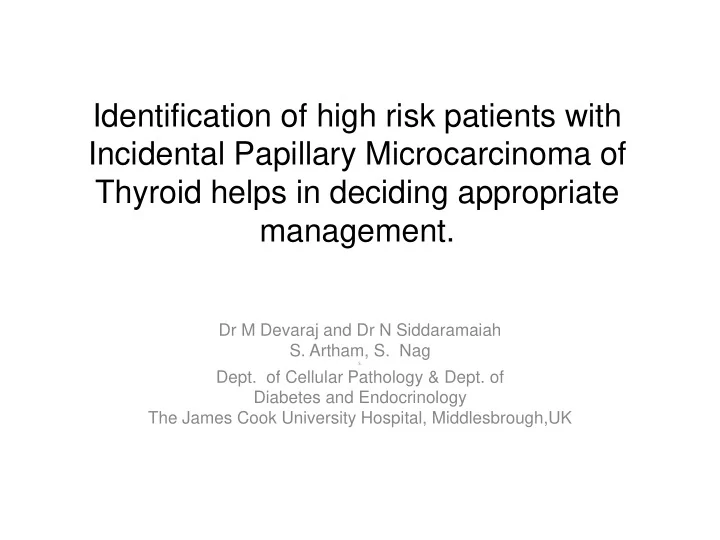

Identification of high risk patients with Incidental Papillary Microcarcinoma of Thyroid helps in deciding appropriate management. Dr M Devaraj and Dr N Siddaramaiah S. Artham, S. Nag S. Dept. of Cellular Pathology & Dept. of Diabetes and Endocrinology The James Cook University Hospital, Middlesbrough,UK
Introduction • Incidence of papillary microcarcinoma (PMC) is increasing • 30-46% - of all papillary carcinoma of thyroid • Better FNA sampling under ultrasound . guidance • Management – lack of consensus for surgical management due to excellent prognosis • Disease specific survival – 99% at 10 and 15 yrs
Introduction • In a large series - Multifocal papillary microcarcinoma – 40%, Lymph node metastasis – 50% , higher incidence in women • High risk factors – associated with higher risk of disease related death • Identification – guide targeted aggressive therapy
Methods • Retrospective review – all cases of PMC • 9 year period -2006 to 2014 • SNOMED histopathology coding • Histology reports – size of tumour (10mm or less) • Clinical notes, lab reports and Trust’s MDT software portal – relevant information
Results • Total papillary microcarcinomas n=30 • Total papillary carcinomas n=113 • PMC = 30 of 113 (26%) • F:M 23:7 • Mean age 49 yrs (20 to 74)
Results Clinical reason for evaluation 9 8 8 7 7 6 5 4 4 3 3 2 2 1 1 1 1 1 1 1 0
Results • History of previous irradiation to neck =1 (laryngeal carcinoma) • Family history of thyroid cancer =1 • FNAC – 1/patient (Thy3 to Thy5 , n=11) • Repeat FNA (n=10): Change to higher category n=3 • Biopsy (n=5): no change in category
Results • Initial surgeries Total Thyroidectomy +/- lymph node dissection Lobectomy +/- isthmectomy
Results Incidental papillary microcarcinoma N=21 (after exclusion of those with suspicious cytology/histology)
Results • Presence of risk factors 9 of 21 patients - size 6-10mm - multifocality - extrathyroidal spread -Infiltrative growth pattern Number of risk factors varied between 1 to 4, commonest were size and multifocality
Results Frequency of high risk features 7 6 5 4 7 7 3 2 1 1 1 1 0 Size ≥ 6mm Multifocal Vascular invasion Extrathyroidal LN metastases spread
Results • Lymph node dissection n=3 (2 with risk factors) • Evidence of spread; n=1 • Management of patients with risk factors Initial total thyroidectomy n=5 Total thyroidectomy n=4 Radio active ablation therapy n=4 (another patient without risk factors received RAI due to associated oncocytic neoplasm)
Results • TSH suppression therapy: 17 of 21 patients • TSH <0.1 was achieved n=6 • Only 4 patients with risk factors achieved this in first 12 months • 2 deaths recorded: unrelated non-thyroidal malignancies
Discussion • Patients with papillary microcarcinoma - excellent prognosis • Disease specific survival 99.9% at 10 and 15 years • Not influenced by extent of thyroidectomy and / RAI therapy • Two or more risk factors – associated with cancer related mortality. • Large US study: age >45yrs, Male patient, African race, nodal metastasis, extrathyroidal spread – affect overall survival
Discussion • Our study - Incidence of papillary microcarcinoma and disease specific survival similar to published results – No consistency was observed in deciding further treatment in the presence of risk factors – Not all patients with 2 or more risk factors had total thyroidectomy and/ or RAI therapy – Low risk factors or no risk factors – had total thyroidectomy
Discussion • All patients discussed at regional Thyroid cancer MDT
Conclusion • To separate incidental papillary microcarcinoma associated with non-malignant lesions from other malignant lesions • Risk factors: effect disease specific survival. These factors should be considered to decide extent of surgery followed by RAI therapy • All patients with incidental papillary microcarcinoma - should be discussed at Thyroid cancer MDT for appropriate management
Conclusion • Clear documentation and communication regarding TSH suppression therapy and target TSH level from MDT should be a standard • Standardisation of histological reporting to include size, multifocality, vascular invasion, capsular and extrathyroidal spread will aid these decisions
References • Papillary microcarcinoma of the thyroid gland.MD Bramley, BJHarrison. BJS 1996 Dec;83(12):1674--83. • Incidental and nonincidental papillary thyroid microcarcinomas. Case series from the Endocrinology clinic and Institute of Pathology Targu Mures Szantoeal. Acta Endo2010Oct-- Dec:6 (4)3 • Papillary microcarcinoma. S Noguchi et al. World J Surg2008;32:747--753 • Should all papillary thyroid microcarcinomas be aggressively treated? An analysis of 18,445 cases. X Yu et al. Ann Surg.2011Oct;254(4):653--60 • Survival impact of treatment options for papillary microcarcinoma of the thyroid. H W Lin, N Bhattacharyya. Laryngoscope 2009 Oct;119(10):1983-- 87. • An observation trial with out surgical treatment in patients with papillary microcarcinoma of the thyroid. Y Ito et al. Thyroid 2003 Apr;13(4):381--87.
Thank you
Recommend
More recommend